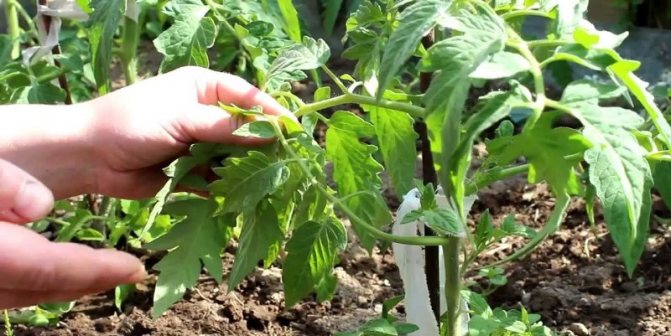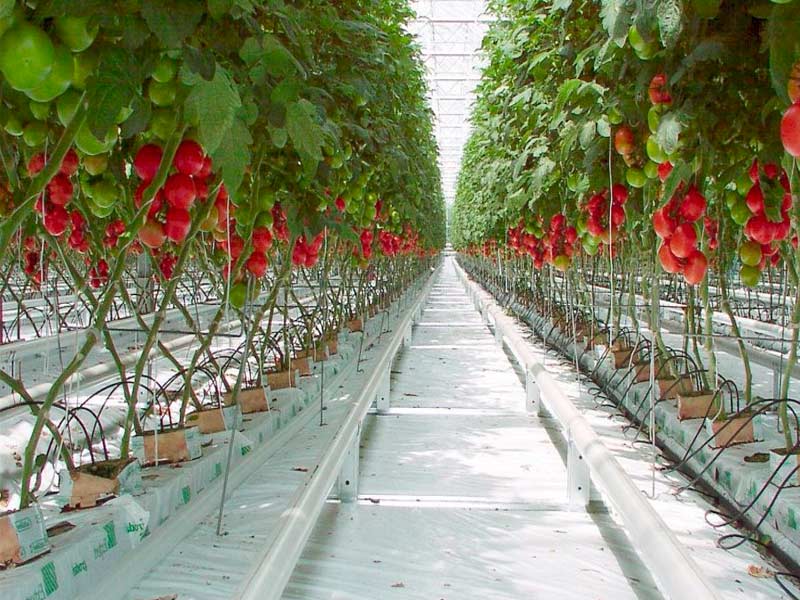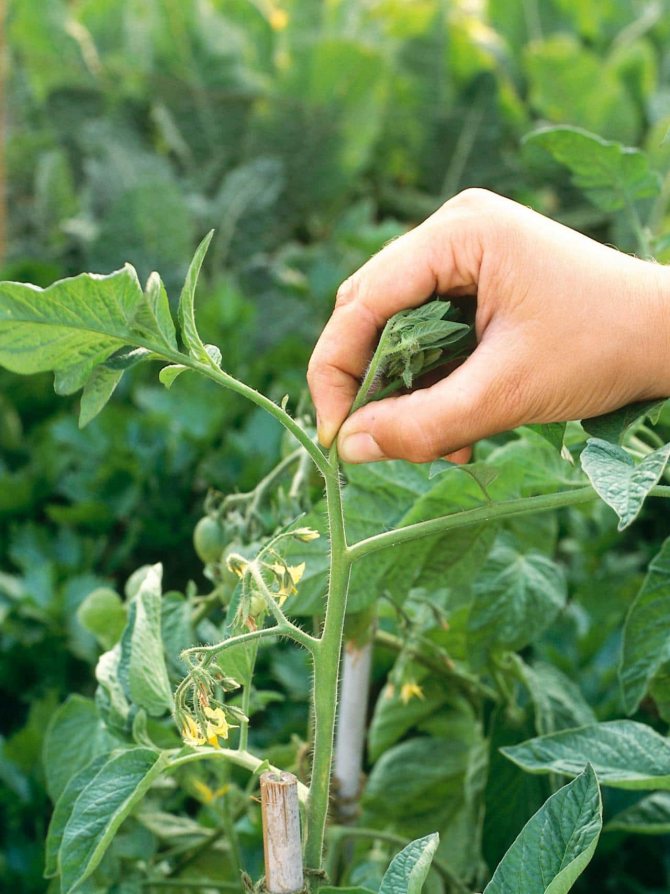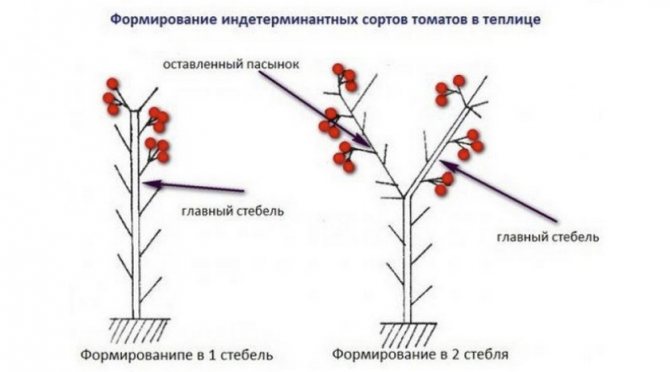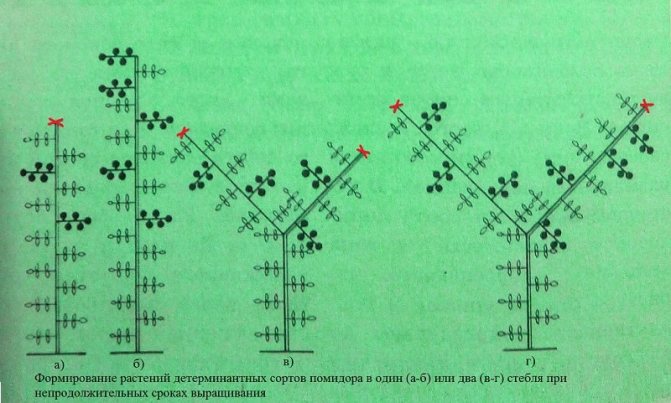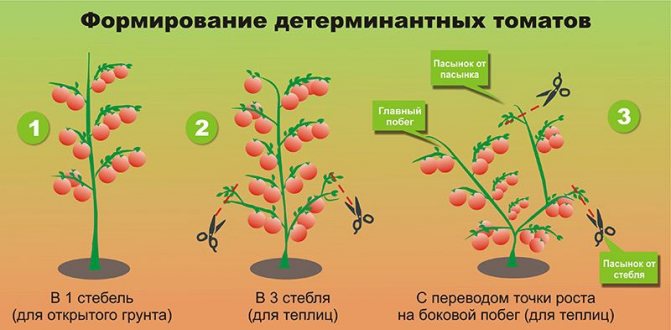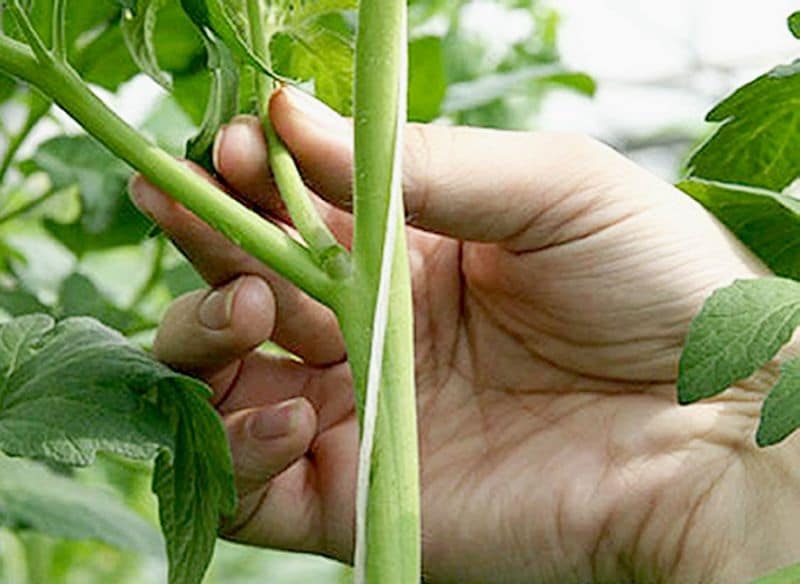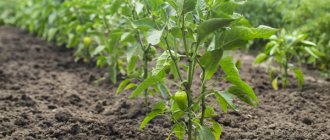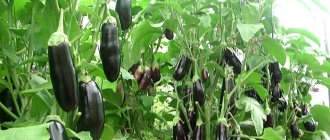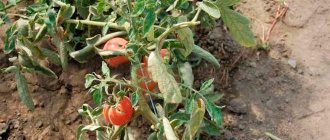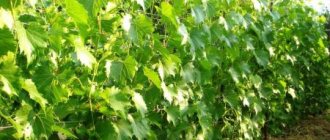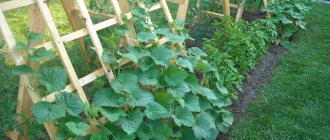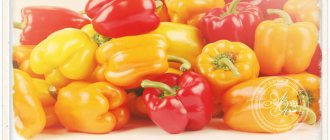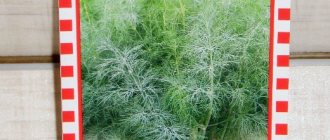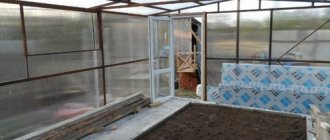Grassing tomatoes
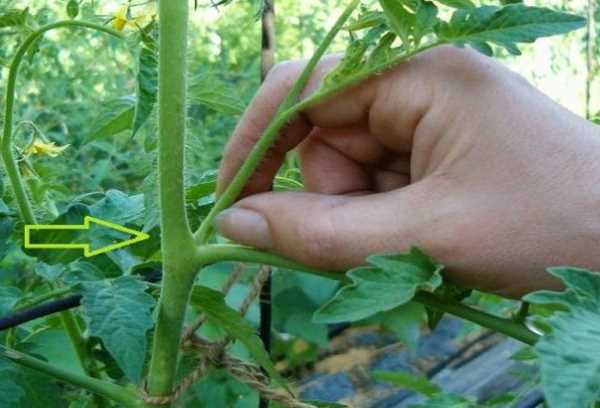
One of the most important activities that is carried out at all stages of tomato development - pinching, removal of side shoots
... Stepsons can simply break off or cut off with scissors, pruners - as it is convenient for anyone.
The main thing is to do this at the beginning of the growth of the stepsons, when they are no more than 5 cm, the procedure will be painless for the plant.
Before removing all the stepsons, you need to decide how many stems you will grow the tomato. If you need a formation of 2 or 3 stems, then you need to leave the necessary lateral shoots in time.
Video - Grassing tomatoes
Bush formation rules
- To get started, you need to purchase rubber gloves, preferably medical, since they are thinner and the hand will be better felt in them. Then, before working in a wide container, dilute the manganese. The manganese solution is needed to dip gloved hands into it. This must be done so that viral infections do not enter the tomatoes.
- The removal of stepchildren should be carried out in the early morning, it is advisable to choose a summer, warm and always sunny day for this. The stepchildren on the stems of the plant must be removed in the morning so that the wounds caused by the evening can dry out.
- It is necessary to remove stepchildren who have grown at least 5 cm. Stepchildren must not be pulled out and plucked from the stem. They need to be pinched. Moreover, the pinching must be done so that after it there is a small column up to about 2 cm.
- It is necessary to constantly monitor the formation of the bush and not allow the stepsons on the stem to be more than 7 cm. The smaller the stepson, the less the possibility of plant disease. The growth of side shoots requires a large proportion of nutrients, which is taken from the main stem, and as a result, because of this, you will have a much smaller tomato crop than you expected.
- In no case should you make docking if you watered or mineral fertilized the plant before this procedure. One of the reasons for this will be that the plant, after watering or feeding, actively begins to assimilate minerals and water. Therefore, it is best to carry out pinching three days after watering or feeding.
How to form tomato bushes?
How many stems do you need to grow tomatoes?
It directly depends on the variety.
Tall tomatoes
it is best to grow in one stem - for this, constantly remove all stepchildren from each leaf axil.


Co medium-sized and low-growing varieties
you need to do it differently. If you want to form a tomato into 2 stems, then leave the stepson growing from under the first inflorescence to form the second stem, he is considered the strongest. We simply delete the rest of the stepsons.
There is another option the formation of low tomatoes
: first we lead the bush into one main stem, removing stepchildren on it up to 3-4 brushes. Then we choose the strongest stepson and keep the plant in 2 stems.
After 1-2 inflorescences, leave one more stepson and then pinch the main stem. Growth processes will intensify. Next, leave 3-4 brushes on the stepson and pinch.
Video - Formation of tomatoes in 1 - 2 - 3 stems
When choosing options for forming a bush, do not forget to focus on the climatic conditions of growing, how many fruit brushes will have time to ripen directly depends on this.
If you do not know what height the plants will grow, and cannot decide how to form a tomato, it is quite simple to calculate. Pay attention to the frequency of arrangement of flower brushes along the main stem - the less often they are located, the higher the plant will be.
In tall tomatoes, the brush is usually formed after 2-3 leaves. The more often the brushes are located, the lower the plant will be.
What you need to know about tomato shaping
The soil and climatic conditions of the homeland of tomatoes, South America, contributed to the emergence and consolidation of the ability for intensive development of vegetative organs at the genetic level. Having overcome the ocean and settled, first in the Old World, and then in Russia, tomatoes have not lost their tendency and, if possible, form side shoots, the number of which reaches 100 or more.
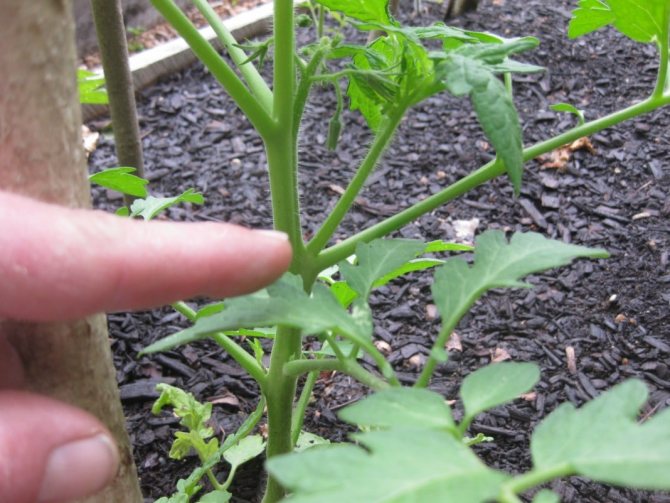

The lateral shoot, formed from the axil of the leaf, is called the stepson
Why are tomato bushes formed?
It would seem that this is good, because it is on the shoots that flower brushes, ovaries appear and, ultimately, fruits ripen. But the abundance of shoots does not lead to large yields. When grown in greenhouses, where there is inevitable competition for resources, it is difficult for a plant to simultaneously grow leaves and ripen a large number of fruits. It is pinching and pinching that help to reduce the load on the bush and direct the energy of the plant in the right direction.
Tip: Tomatoes are light-loving crops. In case of insufficient lighting, they build up excess green biomass. To avoid this, equip the greenhouse with a sufficient number of artificial light sources.
Interesting fact: the dry nutrient that the plant uses to develop only three leaves is enough to ripen one fruit.
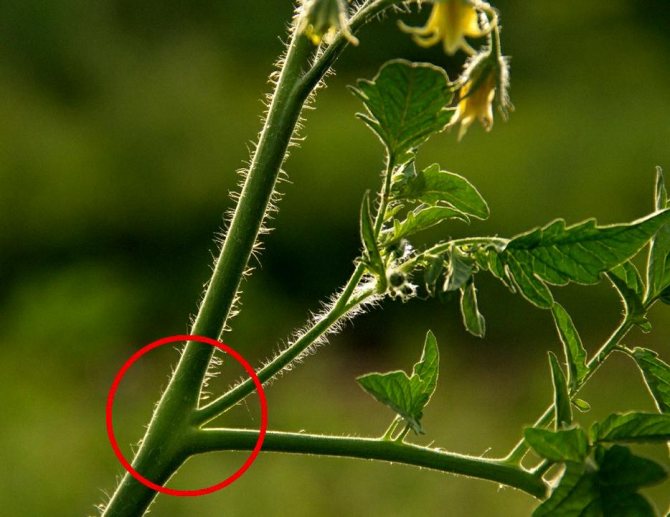

Removing the stepson is one of the stages of the formation of a bush
What will the rejection of the formation of a bush lead to
If you neglect pinching, perhaps you will harvest the expected harvest by weight per unit area, but the quality of the vegetables will not please. Tomatoes will be less than average in size, there will be problems with ripening, and will leave much to be desired in taste and aroma.
Another situation may arise - a lot of leaves on the side shoots will lead to a thickening of the planting, they will become an obstacle to the flow of air and light to the plants.
Thus, the risk of disease occurrence will significantly increase, which will require additional costs for means of protection and with a high degree of probability will reduce the yield.
What is the difference between pinching and pinching and how to do them
The shoot on which the first flower cluster appeared is the main one in tomatoes. Removing the top of this shoot is called pinching or edging. It is performed to stop the growth of the plant in height and to exclude the appearance of unnecessary ovaries. The rest of the shoots appearing in the leaf axils are lateral and are often called stepchildren. Removing them is called pinning.


Grasshopping is carried out after the appearance of the first leaf on the lateral shoot
According to the type of development of the bush, varieties are divided into deterministic and indeterminate. Early ripening and mid-ripening varieties usually have a deterministic type of bush. In late maturing, it is indeterminate. The method of forming tomatoes is determined depending on the variety.
The general principle for all varieties: it is necessary to carry out pinching as new side shoots appear and they reach a length of about 5 cm.
The first time the need to remove stepchildren arises 10-15 days after transplanting. In the future, this operation is performed once a week.
Removing the lower leaves
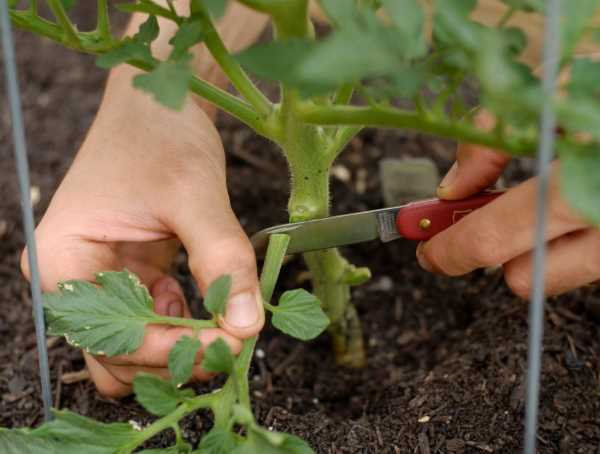

The next important step in the formation of tomatoes is removal of lower leaves
... This must be done in order to improve the ventilation of the bushes, and so that all nutrients go directly to the fruits, and not feed the branches with leaves.
It is necessary to gradually, no more than 2-3 leaves per week, remove all branches to the brush on which the fruits began to ripen.
Tips for proper shaping
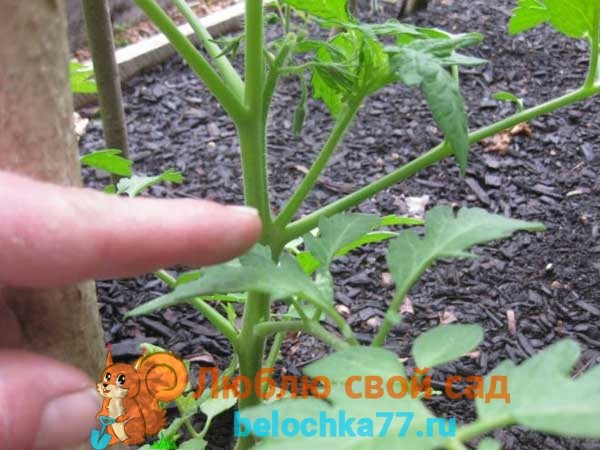

Although different varieties of tomatoes, as well as their growing conditions, have their own formation characteristics, there are still some basic general rules:
- The stepsons are removed carefully, with their hands, preferably with gloves, leaving hemp.
- Overgrown stepchildren can be trimmed, but only with a disinfected tool.
- When forming, the bushes need to be tied up.
- The lower leaves are removed in whole or in part, depending on the planting density, illumination and ventilation of the site.
- Above each inflorescence, 2 leaves must be left to ensure the normal flow of nutrients to the fruits.
- Docking should be done in good weather conditions.
Tomato support
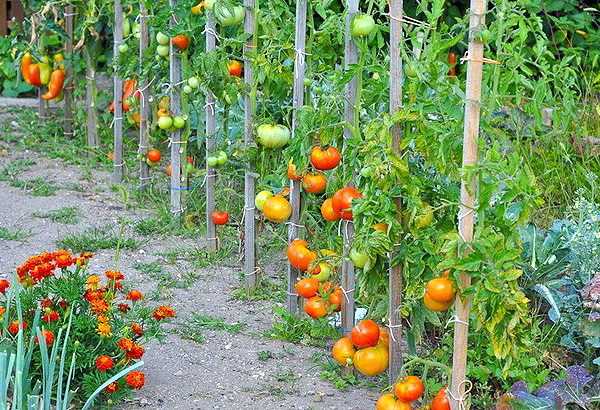

A very important procedure for growing tomatoes
... The garter method itself is usually chosen based on the characteristics of the variety. For example, in a greenhouse, only tall tomatoes will give the maximum yield.
Medium and undersized varieties
will bush, so it is better to grow them outdoors.
This means that different varieties need different ways of garters, props of different sizes will be needed.
For the garter, you will need wooden pegs about 1 meter long. Drive one peg near each bush. Then, with a soft cord for tying plants, do not tie the tomato stem tightly.
As the tomato grows, it is necessary to tie up the stem in several more places.
For tall tomatoes
they also first drive in a peg for a garter, and when they outgrow it, tie the tomatoes to the very top of the greenhouse, and the other side to the peg. As the tomato continues to grow, gently wrap the tomato stem around the soft string.
Pruning leaves from tomatoes
Gradually (when they are no longer needed by the plant), the lower leaves of the tomatoes should also be removed (in addition to the stepsons).
This primarily concerns indeterminate varieties and hybrids when growing them in a greenhouse. And about the nuances of removing leaves in determinant and superdeterminant, read below.
So when the same remove bottom leaves at the tomatoes?
- As a rule, the lower leaves on the stem begin to be removed gradually (1-2 pieces per week, but in no case 3-5 at a time, otherwise the plant will be in a state of shock) during the period of fruit formation. When the fruits on the first cluster are fully formed and begin to pour, by this time they should all be removed.
Important! You need to start removing the leaves from the lowest ones, especially if they suddenly began to fall and literally lie on the ground.
Moreover, you need to remove the lower leaves if they are twisted into a tube, turned yellow.
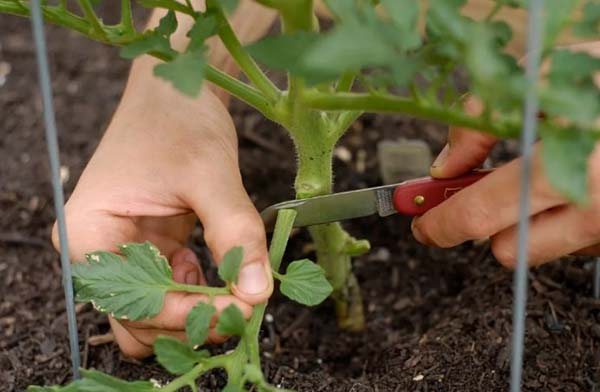

BUT when should delete (cut or trim) leaves above the first brush?
- Similarly, i.e. when the fruits are formed on the second hand, and so on.
However, the leaves above can not be completely removed, but the leaf itself can be cut in half - across the central vein.
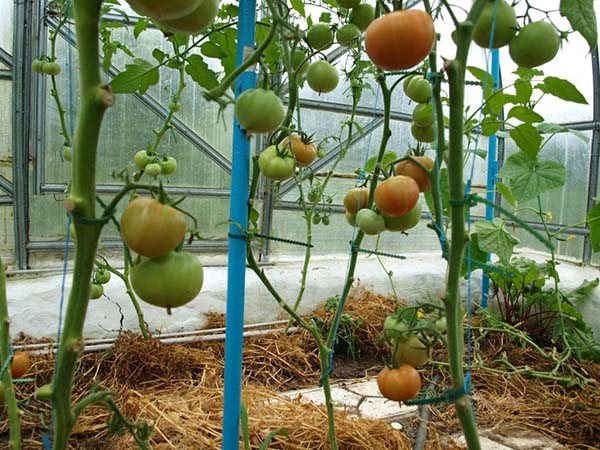

Why delete leaves have tomatoes?
- So that the plant does not get sick with late blight if the lower leaves begin to lie on the ground.
In other words, if the lower leaves touch the ground, then they will become a conductor of diseases from the soil.
- For better ventilation (airflow) of the lower part of the bush.
- To accelerate ripening (the acquisition of fruits of a red or other color).
When are the lower leaves you can leave and not delete?
- In conditions of high humidity and waterlogging, due to frequent rains, the lower leaves can act as a buffer, intercepting moisture and thereby preventing cracking of fruits... Provided, of course, that they are healthy and not in contact with the soil.
- Also, do not remove the leaves when growing tomatoes in the open field, otherwise your tomatoes will simply burn with the sun.
Note! Have determinant (undersized) varieties and hybrids of tomatoes leaves need to be removed, but in smaller quantities and only the lowest ones (which are close to the ground and can touch it), as well as dry, yellowed, painful.
And at superdeterminate tomatoes and it is practically not necessary to remove the leaves at all (except, again, dry, yellowed, in short, superfluous).
Video: when and how to trim the leaves of tomatoes
general information
Tomatoes belong to a heat-loving vegetable crop, but summer is not always pleasing with favorable weather. Gardeners increasingly began to grow vegetables in a polycarbonate greenhouse. Under the shelter, plants are not afraid of temperature fluctuations, precipitation, wind and other unfavorable factors.
Almost all types of tomatoes require pinching, which means cutting off the side branches. Standard types are an exception. This is a kind of determinant group of tomatoes. Growing standard tomatoes is very easy and simple. They do not require the removal of side branches, the formation of a central trunk and tying to a support.
Tomato bushes of the standard type have a strong, powerful stem, which stretches up to 60 cm. 4 fruiting clusters are formed on the stem.
Tall varieties of tomatoes without the formation of the main stem begin to branch in different directions, forming many flowers that do not have time to develop into fruits. Therefore, the formation of tomatoes in the greenhouse is considered a mandatory procedure. Cutting off excess, weak inflorescences will lead to the fact that all forces will be directed to the development of a full-fledged crop.
Passionking is carried out for three main reasons:
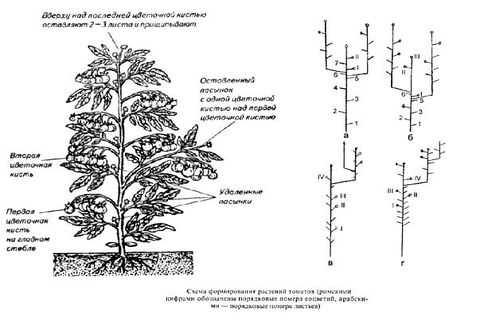

- unlimited growth of the bush leads to the development of numerous lateral flowering branches and ovaries, which need more nutrients and energy for excess greenery;
- a large number of leaves leads to insufficient penetration of sunlight and air to various parts of the plant;
- a formed tomato bush gives a high-quality and abundant harvest.
To carry out the procedure correctly, you need to well distinguish an ordinary sheet from a stepson. Stepsons grow between the main stem and leaves. First, the leaf itself appears, and above, after a while, a stepson begins to form. It turns out that they grow from one point. The upper sprout is torn off without touching the lower one.
How to form a bush, everyone decides independently. For tomatoes in the open field, two trunks are permissible, and in a polycarbonate greenhouse, you can grow with one stem. This is suitable for tall types of tomatoes. Determinant tomato varieties usually have two main stems left in the greenhouse, while open field tomatoes can have three stems.
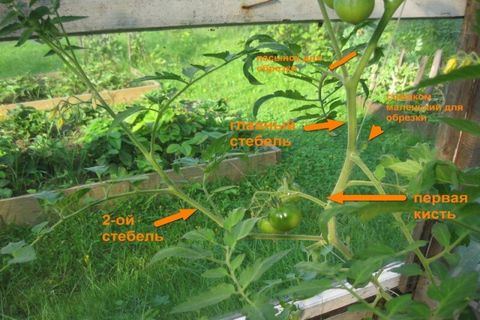

If the stem is properly formed, it will slow down the growth of the vegetable crop and increase the amount of the crop. Growing tomato bushes in a greenhouse and shaping, consists of pinching, pinching and other manipulations.
Formation of indeterminate tomato varieties in the greenhouse
These varieties were created for heated greenhouses, where they were grown all year round. In an unheated greenhouse, of course, it is difficult to use the full potential of indeterminate varieties, but it is quite possible to grow 5-6 brushes. To do this, towards the end of the growing season (in the middle lane it is August 10-15), remove the top and all inflorescences from indeterminate varieties, let the plant "concentrate" on the already set fruits.
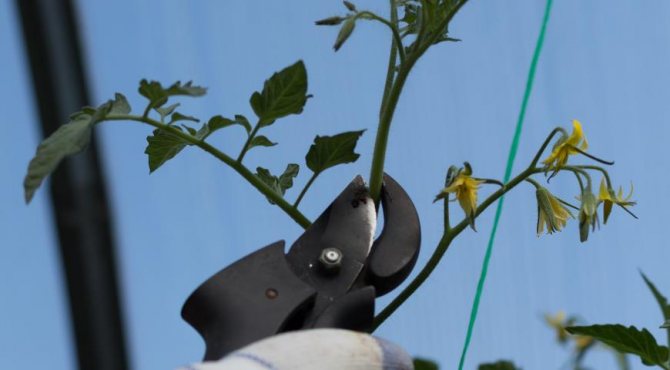

We stop the growth of a bush of indeterminate varieties of tomatoes
These tomatoes have unlimited growth - it would be summer all year round, they would grow indefinitely.
Form them into one stem and nothing else. There is no point in leaving the side shoots - while they grow back, until they bloom (and they lay flower brushes very high), summer is already over. You still can't get fruits from them, but they will take a lot of strength from the plant.
The main difference in the formation of such varieties is the number of fruit clusters.

